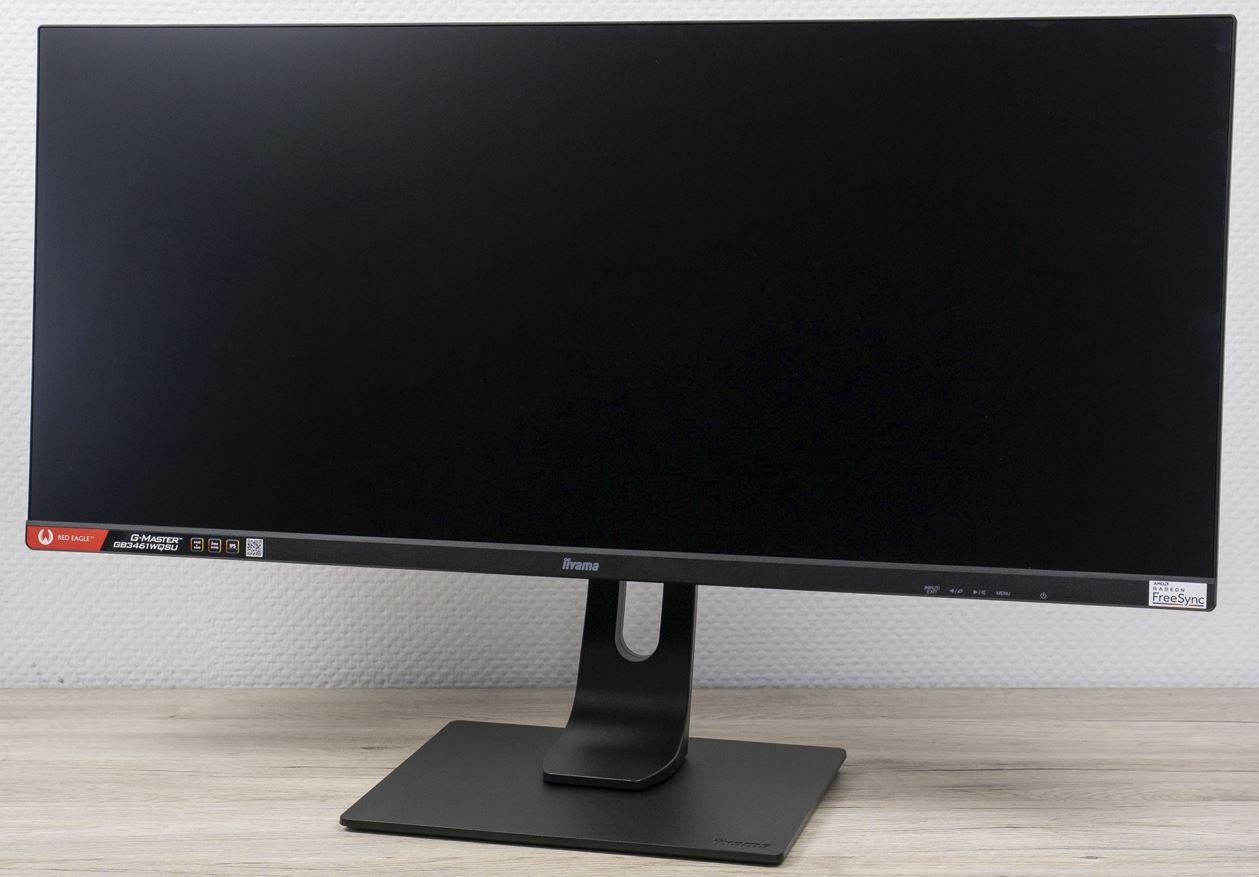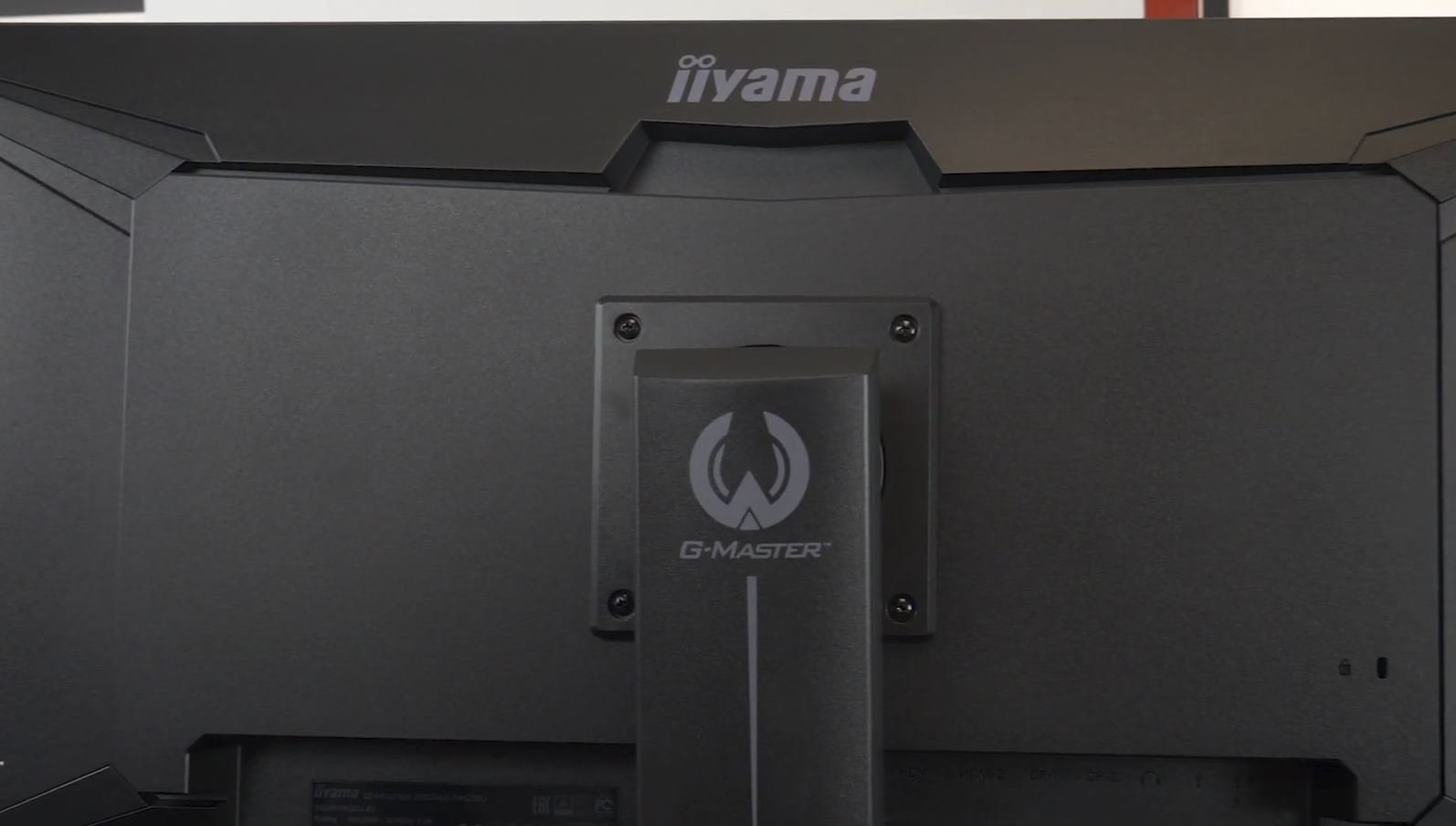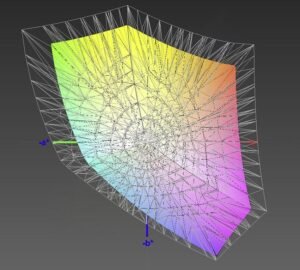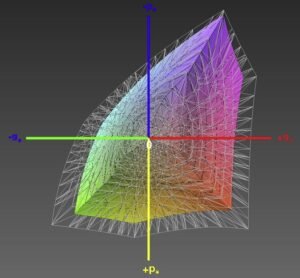34-inch monitor Iiyama ProLite GB3461WQSU-B1 Red Eagle shows a great performance at a bargain price.
Image editing meets gaming is the motto. Acer tries to combine gaming and image processing with the Nitro series.
When it comes to large-format gaming displays, Iiyama has so far held back. With the Iiyama GB3461WQSU (Iiyama G-Master GB3461WQSU-B1 Red Eagle), we have now reached the first gaming monitor from the Japanese manufacturer that corresponds to this group.
The 34 inch has a viewing angle IPS panel in 21: 9 format and has a resolution of 3440 x 1440 pixels. It is no longer uncommon to specify the response time, which is specified as 1 ms MPRT (“Moving Picture Response Time”) and has nothing to do with the classic gray-to-gray measurement. A native update rate of 144 Hz should ensure smooth gameplay, while FreeSync eliminates ” tearing ” and ” stuttering.” Gaming tools such as “Black Tuner,” user-defined game modes, and some ergonomic setting options round off the features of the Iiyama GB3461WQSU.

Acer is trying to kill two birds with one stone with its current Nitro series. Image editing meets gaming is the motto. With the Nitro XV272UP, we have another gaming display to manage this balancing act.
The Acer XV272UP has an IPS panel with a WQHD resolution of 2560 x 1440 pixels. They are silent about the exact switching times and prefer to put a fictitious but more effective advertising value of 1 ms “VRB” in the datasheet, which of course, sounds better than 4 ms “Gray to Gray.” It gets sporty with a native update rate of 144 Hz. Various gaming tools are also offered.
In addition to the game properties, the description also relies on color fidelity, the vast DCI-P3 color space, and a display HDR400 certification to appeal to film lovers.
In summary, another egg-laying woolly milk sow has reached us. We will clarify on the following pages whether the Acer XV272UP can convince us about these promises.

Detailed information on the features and specifications can be found here:
Specification
| Iiyama G-Master | Acer Nitro | |
| $ | CHECK PRICE | CHECK PRICE |
| Released | May 7, 2021 | January 28, 2019 |
| Brand | Iiyama G-Master | Acer |
| Panel Type | IPS | IPS |
| Dimension | 817 x 415 x 230mm | 614 x 367 x 66 mm |
| Weight | 12.8kg | 6.46 kg |
| Screen Size | 34 Inches | 27” |
| Resolution | 3440 x 1440 | 2560 x 1440 |
| Aspect Ratio | 21:9 | 16:9 |
| Refresh Rate | 144 Hz | 144 Hz |
| Response Time | 1ms | 1ms |
| Adaptive-Sync | FREESYNC PREMIUM | AMD FREESYNC |
| Ports | x2 (v.3.0) HDMI x2 (v.2.0) DisplayPort x2 | 2x HDMI 1x DisplayPort 1x USB 3.0 4x USB 3.0 |
| Built-In Speakers | 2 x 5W | 2 x 2 W |
| Pixels Per Inch | 110 PPI | 108.79 PPI |
| Brightness | 350 cd/m² | 400cd/㎡ |
| Contrast Ratio | 1,000:1 | 1,000:1 |
| Colors | 8-bit 16.7M | 1.07 Billion |
| Power Consumption | 49W | 32.50 W |
Design
When it comes to large-format gaming displays, Iiyama has so far held back. With the Iiyama GB3461WQSU (Iiyama G-Master GB3461WQSU-B1 Red Eagle), we have now reached the first gaming monitor from the Japanese manufacturer that corresponds to this group.
The 34-inch display has a viewing angle IPS panel in 21: 9 format and has a resolution of 3440 x 1440 pixels. It is no longer uncommon to specify the response time, which is specified as 1 ms MPRT (“Moving Picture Response Time”) and has nothing to do with the classic gray-to-gray measurement. A native update rate of 144 Hz should ensure smooth gameplay, while FreeSync eliminates ” tearing ” and ” stuttering.” Gaming tools such as “Black Tuner,” user-defined game modes, and some ergonomic setting options round off the features of the Iiyama GB3461WQSU.
Acer is trying to kill two birds with one stone with its current Nitro series. Image editing meets gaming is the motto. With the XV272UP (Nitro XV272UP), we have another gaming display to manage this balancing act.
The Iiyama GB3461WQSU has a frameless design. A 2 mm narrow band surrounds the panel at the top and sides. However, as with all borderless monitors, the visible image only begins a further 7 mm inwards. The lower frame has a height of 20 mm. The manufacturer’s logo is located in the middle in a subtle gray.
Furthermore, a wide feature badge is placed on the left of the logo and a badge on the right that provides information that the Iiyama GB3461WQSU is a FreeSync model. Both stickers can be easily removed if necessary.
The small operating LED is placed to the right of the imprint. It lights up blue during operation and orange on standby. It doesn’t bother you because it doesn’t shine too brightly. It can still be deactivated in the OSD menu.
The depth of the display is 20 mm on the outside – it increases slightly towards the center of the rear wall. There are ventilation slots on the top of the case, under which the monitor speakers are visible. The connection panel with vertical cable routing is attached below the housing. The bracket’s retaining plate is connected to the rear panel with four screws. The Iiyama GB3461WQSU can also be attached to VESA 100 brackets if these are removed.

The Acer XV272U has an IPS panel with a WQHD resolution of 2560 x 1440 pixels. They are silent about the exact switching times and prefer to put a fictitious but more effective advertising value of 1 ms “VRB” in the datasheet, which of course, sounds better than 4 ms “Gray to Gray.” It gets sporty with a native update rate of 144 Hz. Various gaming tools are also offered.
In addition to the game properties, the description also relies on color fidelity, the vast DCI-P3 color space, and a display HDR400 certification to appeal to film lovers.
In summary, another egg-laying woolly milk sow has reached us. We will clarify on the following pages whether the Acer XV272UP can convince us about these promises.
The Acer XV272U is made of black plastic. The display has a frameless design at the top and on the sides, but as with all other frameless displays, the visible image is offset a little further inwards. In our test model, the distance is 10 mm. At the bottom, the frame is about 28 mm wide and shows the Acer logo in the middle and a badge with the inscription “Color Accuracy” on the left, which is supposed to mean that the XV272U already has a very neutral color match ex-works. The operation LED is on the right. It lights up blue during operation and yellow on standby.
On the top left is the Acer logo, which is set apart from the aluminum surface design as a relief. The lower half of the back wall has a finer, velvet-like structure. The operating unit for the OSD menu can be found here on the left-hand side and a large niche for the connection panel at the bottom.
The joint behind the support arm’s retaining plate is used both for the tilt angle of 20 ° to the rear and -5 ° to the front and the pivot function, which allows rotation from landscape to portrait mode.
The rotation is not restricted to one direction but works in both directions. Although there is a locking mechanism at the end positions, it is so imprecise and spongy that it has to be readjusted manually so that the display is at a right angle.
The height adjustment is realized by a slide that runs inside the support arm and allows a path of 120 mm. The lower frame is 45 mm from the table surface in the lowest position.
Although the diameter is only 230 mm, the display is very stable and can withstand rough shocks without being unbalanced.

Display
Iiyama G-Master- When reset, the monitor sets the following values: brightness 80, contrast 50, sharpness 50 (fixed), color temperature “user setting,” and I-style color “off.” These values were used for the subsequent assessment with the factory settings.

The grayscale reproduction of the Iiyama GB3461WQSU is good. The last field is cut off in the highlights, and in the shadows, you can still distinguish the third from the last field from the black background. But if you move only a little out of the center of the image axis, the light gray tones acquire a turquoise cast. In addition, the dark gray tones lose two more areas of their recognizability.
The usual color edge, where pure white merges into light gray, is already evident when looking at it from the front. Often pure white is obtained at a side angle yellowing, which is not the case with this panel. The colored edge is also not more pronounced at extreme viewing angles.
Brightness, black level, and contrast: The measurements are carried out after calibration to D65 as the white point. If possible, all dynamic controls are deactivated. Due to the necessary adjustments, the results are lower than when the test series was carried out with the native white point.
A black border does not surround the measurement window. Therefore, the values can be compared with the ANSI contrast and reflect real-world situations much better than measurements of flat white and black images.

We achieved a maximum of 321 cd / m² with the native white point. That is around 10% less than the manufacturer’s information, 350 cd / m². 291 cd / m² are left when the necessary corrections have been made to get to D65. With a minimum brightness of 69 cd / m², the display can be turned down far enough to work in absolute darkness.
The average contrast ratio is 943: 1 and runs very evenly over the brightness range. However, with a maximum contrast ratio of 985: 1 at 0% luminance, the manufacturer’s specifications of 1000: 1 are not quite achieved. After calibration, the contrast ratio reaches 935: 1. Overall, that’s a good result.
Colour reproduction- In the case of monitors for the consumer and office sector, we first test the color rendering in the factory settings after the reset and – if available – in an sRGB mode. The monitor is then calibrated with Quato iColor Display. We use our software for the measurements; the X-Rite i1Display Pro colorimeter and the X-Rite i1Pro spectrophotometer are used as measuring devices.


When examining the color space, we first determine the coverage of the sRGB color space. The Iiyama GB3461WQSU provides a coverage of 99% before and after calibration, which corresponds to a very good result.
Latency is an important value for gamers; we determine it as the sum of the signal delay and half the average frame change time. With the Iiyama GB3461WQSU, we measured a very short signal delay of 1 ms. Half the average picture change time is also very short at 3.3 ms. Overall, this makes a total latency of 4.3 ms, which is particularly suitable for fast shooter games.
The graphics card reports that FreeSync is working from 48 to 144 Hz. In this range, tearing and stuttering are effectively prevented. The picture gets better with increasing frame rate but should not exceed 144 Hz, as you then go outside the FreeSync range again.
FreeSync works flawlessly and again increases the pure 144 Hz mode, completely without tearing and stuttering.
Acer Nitro- When reset, the monitor sets the following values: Brightness 80, Contrast 50, Super Sharp “Off,” Gamma 2.2, Color Temperature “Warm,” Image Mode “Standard.” These values were used for the subsequent assessment with the factory settings.

A very good grayscale representation is achieved in the lights, as all gray tones stand out against the pure white background. In addition, no color cast can be seen. The image is a bit too dark in the shadows. Here the fields stand out only up to the fourth from the last field. The gray gradient is very nice and homogeneous except for the light step of color near the center. The color stairs from about 30 degrees act prominent with a side angle. In addition, the light gray levels have a bluish cast.
Brightness, black level and contrast- After calibration to D65 as the white point, the measurements are carried out. If possible, all dynamic controls are deactivated. Due to the necessary adjustments, the results are lower than when the test series was carried out with the native white point.

A black border does not surround the measurement window. Therefore, the values can be compared with the ANSI contrast and reflect real-world situations much better than measurements of flat white and black images.
With the native white point, the Acer XV272U achieves a maximum luminance of 347 cd / m². That is almost a precision landing at the stated 350 cd / m² of the datasheet. To get to D65, the RGB controls have to be adjusted a bit downwards, but the luminance here is 100% brightness, with 352 cd / m² a bit higher. With 88 cd / m² as the lowest luminance, the panel is a bit too bright for working in absolute darkness.
In terms of contrast ratio, the Acer XV272UP’s IPS panel is on top. With an average contrast ratio of 1178: 1, it achieves an excellent result. After calibration, the average contrast ratio drops only minimally to 1149: 1.
In the case of monitors for the consumer and office sector, we first test the color reproduction in the factory settings after the reset and – if available – in an sRGB mode. The monitor is then calibrated with Quato iColor Display. We use our software for the measurements; the X-Rite i1DisplayPro colorimeter and the X-Rite i1 Pro spectrophotometer are used as measuring devices.
When examining the color space, we first determine the coverage of the sRGB color space. A coverage of 97% was achieved in sRGB mode before calibration. In the factory settings, even 100% and after calibration 99% are achieved, which can only give a very good result in all cases.
Colour reproduction- In the case of monitors for the consumer and office sector, we first test the color reproduction in the factory settings after the reset and – if available – in an sRGB mode. The monitor is then calibrated with Quato iColor Display. We use our software for the measurements; the X-Rite i1DisplayPro colorimeter and the X-Rite i1 Pro spectrophotometer are used as measuring devices.


When examining the color space, we first determine the coverage of the sRGB color space. A coverage of 97% was achieved in sRGB mode before calibration. In the factory settings, even 100% and after calibration 99% are achieved, which can only give a very good result in all cases.
Latency is an important value for gamers; we determine it as the sum of the signal delay and half the average frame change time. The Acer XV272UP shows an excellent total latency of only 5 ms with a very short delay of 1 ms and an equally fast average picture change time of 4 ms. This makes the device suitable for fast shooters.
When FreeSync is activated, the result is almost identical to 144 Hz, and FreeSync is deactivated. Just that tearing no longer plays a role at all. Again, maximum overdrive is not an option due to the intense corona formation.
Although the Acer XV272U is not an official G-Sync Compatible display, we did not notice any flickering or problems with synchronizing between the computer and the display in our test games. When FreeSync is switched on, the overdrive is set to “Normal.”
Connectivity
Although the Iiyama GB3461WQSU cannot be operated in pivot mode, it is possible to rotate the display to a large extent to reach the connection panel with vertical cable routing. This means that the cable can be changed without any problems. The connectivity is very good, with two connections for HDMI 2.0 and DisplayPort 1.2. There are also two USB 3.0 ports available, one of which is marked yellow and supports devices with a quick charge function. There is a 3.5 mm jack for headphones.
With two HDMI 2.0 interfaces and a DisplayPort 1.4, the Acer XV272UP has good connectivity. In addition, peripheral devices can be connected via four USB ports. Two of them are located on the side and therefore easily accessible on the left outside. One of the ports has a quick charge function. There is also an audio output for headphones on the connection panel, suitable for a 3.5 mm jack plug. There is a 3.5 mm jack socket for headphones. The connection panel is easily accessible in a niche that can cover with a cover to preserve the rear wall’s design.
The sound of the two speakers, which each have 5 watts and are located behind the ventilation slots, is good compared to other monitors. Of course, they are not a substitute for a sound system, but they are useful for playing background music.
Conclusion!
The Iiyama GB3461WQSU is a gaming display that doesn’t have to hide from the big players in terms of performance. With a current street price of just under 500 USD, it can be called a bargain, as it is the cheapest gaming screen among the 34-inch models. This makes it a buy recommendation.
The Acer Nitro XV272U (XV272UP) can draw on unlimited resources in terms of equipment. In addition to the complete ergonomics program, the display is equipped with a good number of connections. It also offers an enormous range of functions. The design seems a bit inconsistent due to the narrow support arm and the round base plate, but in the end, it should be a personal matter of taste.
With a price of 430 USD, the Acer XV272U is average compared to other displays. In return, the screen offers decent all-rounder properties, and we recommend buying it.



